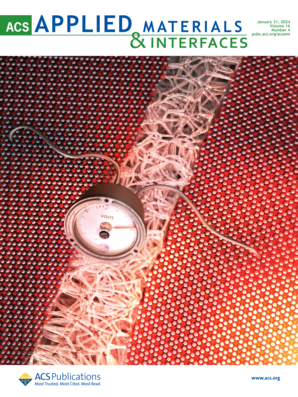Cascade DNA Structural Transitions Enable Stimuli-Responsive Hydrogels
IF 8.3
2区 材料科学
Q1 MATERIALS SCIENCE, MULTIDISCIPLINARY
引用次数: 0
Abstract
Cascade interactions are fundamental to enzyme catalysis and cellular activities, enabling dynamic and adaptive responses to environmental stimuli. DNA-based cascade systems have been widely employed to mimic biological processes, such as immune responses and DNAzyme catalysis, achieved mainly through the hybridization interaction. Herein, we present a cascade DNA system involving single-stranded sequences, noncanonical cofactor-bridged duplexes, and canonical duplexes to construct and dissociate hydrogel matrices. In this work, thymine-rich oligonucleotides (T-strands) exist as single-stranded random coils in a buffer at pH 7.2. Upon the introduction of a low-molecular-weight cofactor, melamine (MA), a supramolecular noncanonical configuration, termed the T-MA-T duplex, is formed. Subsequent addition of adenine-rich oligonucleotides (A-strands) to the system leads to the replacement of MA cofactors and the formation of more energetically favorable canonical A-T duplex structures. These consecutive structural transitions are further utilized as dynamic bridging elements in stimuli-responsive DNA hydrogels, facilitating liquid–hydrogel–liquid phase transitions. Moreover, we demonstrate precisely controlled release profiles of doxorubicin from the DNA hydrogel. This approach, leveraging both noncanonical and canonical DNA configurations in triggered cascade structural transitions, opens avenues for developing molecular switches, electronic nanodevices, adaptive materials, and other advanced applications.

级联DNA结构转变使刺激反应水凝胶成为可能
级联相互作用是酶催化和细胞活动的基础,能对环境刺激做出动态和适应性反应。基于 DNA 的级联系统已被广泛用于模拟生物过程,如免疫反应和 DNA 酶催化,主要通过杂交相互作用实现。在这里,我们提出了一种级联 DNA 系统,涉及单链序列、非规范辅助因子桥接双链和规范双链,用于构建和解离水凝胶基质。在这项研究中,富含胸腺嘧啶的寡核苷酸(T 链)在 pH 值为 7.2 的缓冲液中作为单链随机线圈存在。在引入低分子量辅助因子三聚氰胺(MA)后,形成了超分子非对称构型,即 T-MA-T 双链。随后在该系统中加入富含腺嘌呤的寡核苷酸(A 链)后,三聚氰胺辅助因子被取代,并形成能量更高的标准 A-T 双链结构。这些连续的结构转变被进一步用作刺激响应 DNA 水凝胶中的动态桥接元件,促进液-水凝胶-液相转变。此外,我们还展示了 DNA 水凝胶中多柔比星的精确控制释放曲线。这种方法在触发级联结构转换中利用了非规范和规范 DNA 构型,为开发分子开关、电子纳米器件、自适应材料和其他先进应用开辟了途径。
本文章由计算机程序翻译,如有差异,请以英文原文为准。
求助全文
约1分钟内获得全文
求助全文
来源期刊

ACS Applied Materials & Interfaces
工程技术-材料科学:综合
CiteScore
16.00
自引率
6.30%
发文量
4978
审稿时长
1.8 months
期刊介绍:
ACS Applied Materials & Interfaces is a leading interdisciplinary journal that brings together chemists, engineers, physicists, and biologists to explore the development and utilization of newly-discovered materials and interfacial processes for specific applications. Our journal has experienced remarkable growth since its establishment in 2009, both in terms of the number of articles published and the impact of the research showcased. We are proud to foster a truly global community, with the majority of published articles originating from outside the United States, reflecting the rapid growth of applied research worldwide.
 求助内容:
求助内容: 应助结果提醒方式:
应助结果提醒方式:


